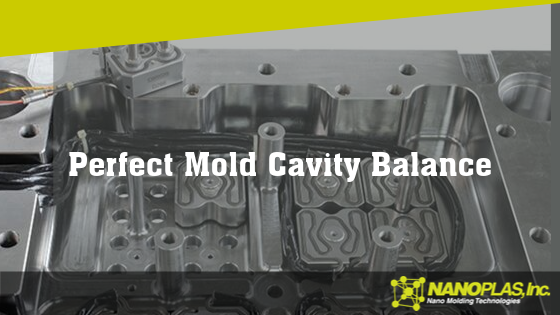
In all phases of the molding process—first stage, second stage and cooling—the cavities must be treated the same. If not, you run the risk of several different injection molding defects. We can prevent these issues in advance by ensuring six key factors are as they should be.
What is Cavity Balance?
The measure of how evenly a multicavity mold fills is called cavity balance. Multicavity molds aren’t as consistent as single-cavity molds, but since multicavity molds can usually produce parts at a lower cost, it’s essential to make sure the mold is designed for a balanced multicavity. If one cavity fills ahead or behind the others, the plastic in that cavity will process differently, resulting in a different part.
We should emphasize the importance of cavity balance throughout the entire process. During the fill, pack, hold, gate seal, shear and cooling phases, every cavity must be experiencing equal conditions.
Injection Molding Defects Caused by Poor Cavity Balance
If you don’t have proper cavity balance in your mold, you could end up facing:
- Short shots
- Flash
- Sink
- Burns
- Voids
- Dimensional issues
- Warp
- Sticking
- Gloss
This is a pretty big range of issues that can derail your production and potentially your cost savings of using multicavity molds.
Six Factors for Perfect Cavity Balance
In order to ensure cavity balance, the following conditions must be equal in all cavities:
- Flow length
From the material inlet to each cavity, the flow length should be designed to be the same for all cavities.
- Flow diameter
Similar to the importance of flow length, the flow diameter through the runners has to be equal for each cavity. Varying flow diameters can cause a whole new set of problems.
- Shear
Even with identical flow length and diameters, eight-cavity molds will still run with imbalance as the four inner cavities usually fill before the outer cavities. This can be combatted with John Beaumont’s MeltFlipper®, which solves the root cause of imbalance. You can also add a hot-runner system that lets you group four cavities at a time, although you could still find problems with shear imbalance, albeit not as sever.
- Cooling
Efficient cooling is required to ensure there are no differential mold temperatures. Start the inlet water at the center of the mold, look for a mold surface temperature variation of 10° F and the difference between water inlet and outlet temperature of any circuit should be a maximum of 4° F.
- Venting
Equal venting of all cavities lets them each experience the same conditions. If one cavity is poorly vented, it will probably burn or short.
- Clamp pressure
Without equal clamp pressure applied across a mold, you risk non-uniform venting.
Multicavity molds are great for production time and cost savings as long as you ensure these six key factors are consistent every single time.
Want to learn more? Check out these other great articles that solve common injection mold issues:
- Fix Ejector Pin Marks in Your Injection Mold
- Eliminate Parts Sticking On Ejectors
- Injection Molding Buildup: Causes and Solutions
- How to Eliminate Plastic Delamination
- Troubleshooting Injection Mold Gate Blush
Source: Injection Molding Advanced Troubleshooting Guide: The 4M Approach by Randy Kerkstra and Steve Brammer.
